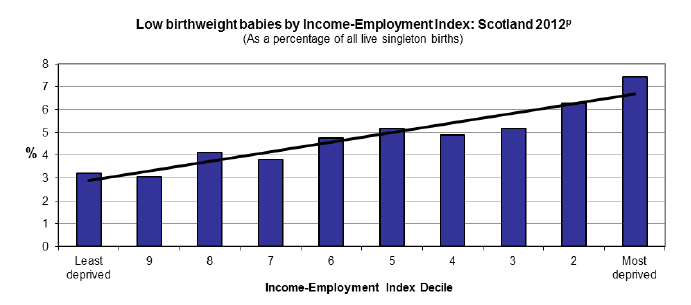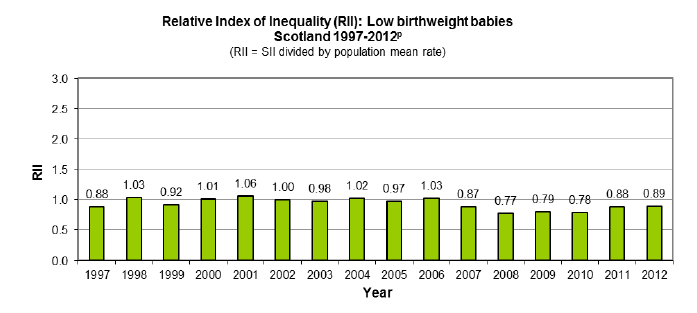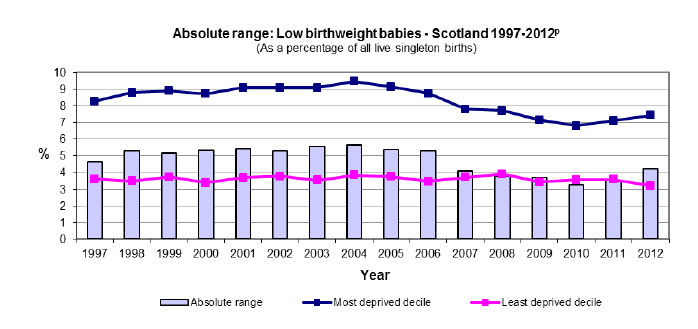Long Term Monitoring of Health Inequalities: Headline Indicators – October 2014
Annual update of the 'Long-term Monitoring of Health Inequalities' headline indicators.
This document is part of a collection
Low Birthweight
Low birthweight (less than 2.5 kg) is a major determinant of infant mortality and morbidity[7]. Despite a decrease in 2012, around 2,800 low birthweight babies are born in Scotland each year, accounting for 5-6% of total live singleton births.
Low birthweight babies are more common in deprived areas than in areas of low deprivation. In 2012, 7.4% of live singleton births in the most deprived areas were recorded as low birthweight, compared to 3.2% in the least deprived. Inequalities were broadly stable between 1998 and 2006, but narrowed in both relative and absolute terms between 2006 and 2010. This was due to a falling percentage of low birthweight babies in the most deprived areas, while the proportion in the least deprived areas remained fairly stable.
Since 2010, there have been consecutive increases in the rate in the most deprived areas, leading to more inequality in both relative and absolute terms. In the last year, while the absolute gap between the most and least deprived areas has widened, there has not been a correspondingly large increase in relative inequality, largely driven by reductions in the rate in the second and third most deprived deciles. Inequalities in 2012 remain fairly low when viewed over the long term.
Note that data for 2012 are provisional, and relative inequality for 2008 has been revised in this report (details included in Annex 2).
Inequalities gradient in 2012

Relative Index of Inequality (RII) over time

Absolute range over time

Scale / context
| Number of low BW babies |
Target population size (live singleton births) |
Percentage |
|
|---|---|---|---|
| 1997 |
3,149 |
56,982 |
5.5 |
| 1998 |
3,108 |
55,152 |
5.6 |
| 1999 |
3,098 |
52,726 |
5.9 |
| 2000 |
2,906 |
51,057 |
5.7 |
| 2001 |
2,848 |
49,744 |
5.7 |
| 2002 |
2,910 |
48,950 |
5.9 |
| 2003 |
3,026 |
50,069 |
6.0 |
| 2004 |
3,030 |
51,807 |
5.8 |
| 2005 |
3,058 |
51,436 |
5.9 |
| 2006 |
2,939 |
52,467 |
5.6 |
| 2007 |
3,095 |
55,271 |
5.6 |
| 2008 |
3,134 |
56,929 |
5.5 |
| 2009 |
2,894 |
56,106 |
5.2 |
| 2010 |
2,815 |
56,063 |
5.0 |
| 2011 |
2,944 |
55,965 |
5.3 |
| 2012p |
2,761 |
55,223 |
5.0 |
Contact
Email: Craig Kellock
There is a problem
Thanks for your feedback